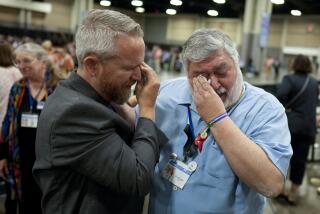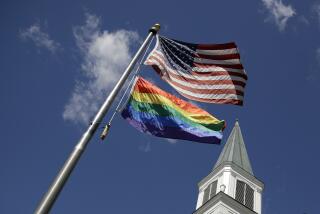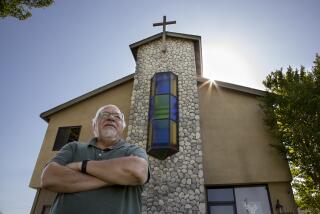1 1/2-Decade Decline Worries Officials : Methodists Seeking New Members
WASHINGTON — Plagued by a membership decline for 1 1/2 decades, the United Methodist Church--the nation’s second-largest Protestant denomination--is setting some ambitious growth goals.
The denomination’s Council of Bishops has set a goal of creating 200 new churches and 150 Sunday schools a year. Officials say U.S. membership is at 9.16 million now, 9.4 million if overseas members are included.
At the same time, the bishops also agreed to initiate a major effort throughout the denomination to revitalize the local church.
The membership decline--from a high of 10.5 million in 1970--has been the subject of fierce debates in the denomination, as conservatives have charged that the liberal, social action positions of the church in the late 1960s and early 1970s drove people out of the body.
But Bishop James Ault, new president of the council, rejected the effort to polarize social action and evangelism, saying the blame for the decline in members could not be traced to Methodist involvement in social issues.
“From my perspective it is not a question of more personal salvation and less social action,” he said, “but more, more, more of each if a local church is to be faithful to Jesus Christ as Lord of the Gospel for which He came and died.”
Ault also stressed the role of the local congregation, telling the bishops that they must take the lead in encouraging grass-roots Bible study, evangelism and commitment to global mission.
In particular, he said there is “far too much biblical illiteracy” in the local congregations.
United Methodists, he said, need a biblical foundation so they can “understand the Christian faith and not confuse it with civil religion or any other kind of idolatry.”
The council, in a “statement of commitment,” said it believes the church can double its ministry and membership by increasing the number of people reached by local congregations.
“We, therefore, commit the full resources of our offices and congregations to reach out to people whom God is seeking and who are seeking God,” the statement said.
In addition to starting 200 new churches from the national level, the bishops said they wanted to recruit 300 already-established congregations each year to help sponsor at least two new congregations, with many of those targeted for ethnic minority communities.
They agreed to set aside $3 million each year at the national church level to help establish new congregations and said they would raise additional money at the annual conference (regional) and local level.
Underscoring the financial need was Bishop Elias Galvan of Phoenix, who told his colleagues that he could start 15 new congregations immediately if financial resources were available.
Other goals established by the bishops included:
- Increasing Sunday school attendance by 3%.
- Increasing by 10% the number of youth served by the church.
- Finding 150 new ministers or directors of Christian education.
- Identifying 2,000 young people to become candidates for the ministry.
- Recruitment of 100 new missionaries.
The 1984 General Conference of the denomination--its highest decision-making body--called for efforts to double United Methodist membership by 1992.
More to Read
Sign up for Essential California
The most important California stories and recommendations in your inbox every morning.
You may occasionally receive promotional content from the Los Angeles Times.










